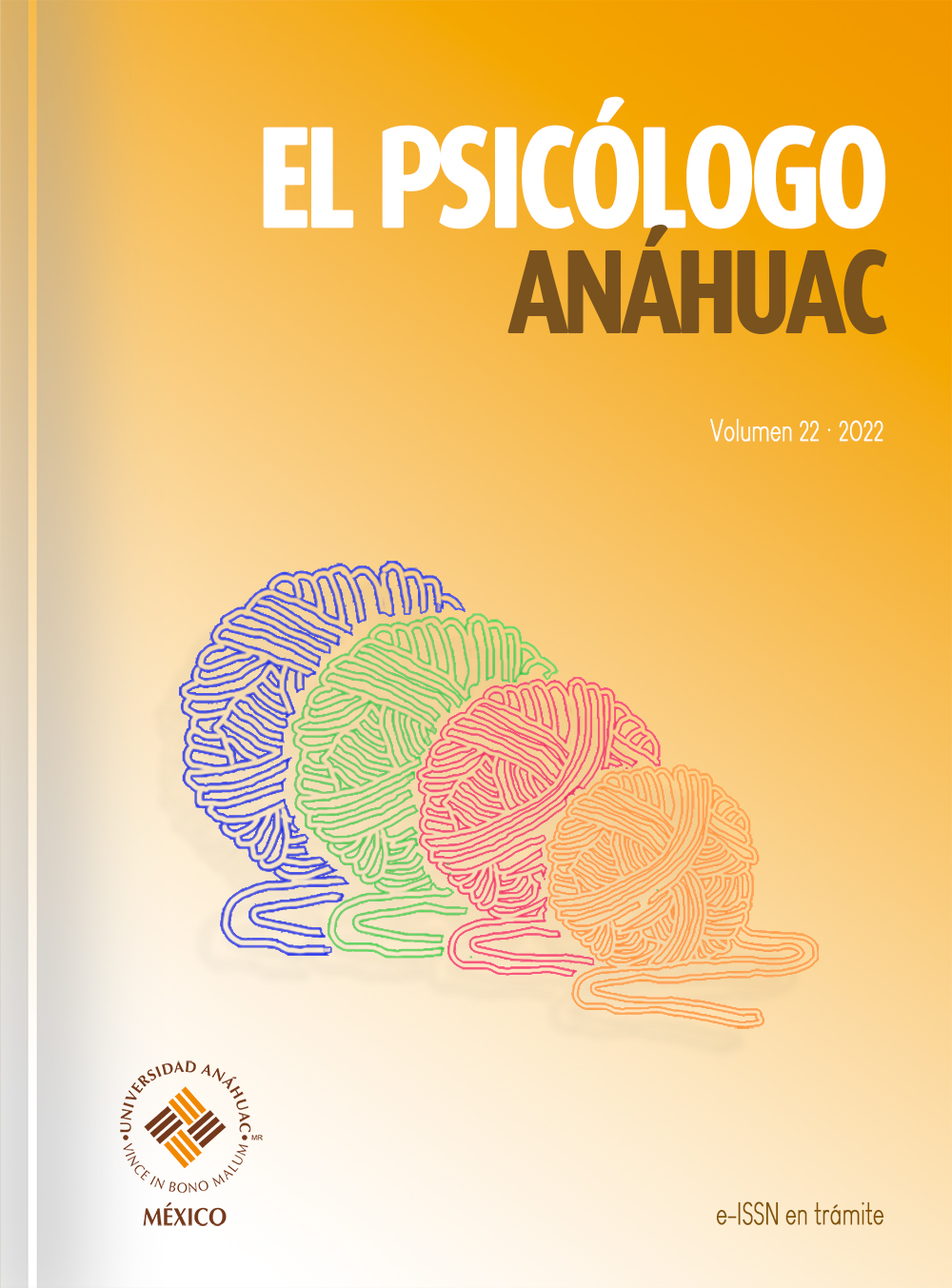Perfiles de espectadores dentro de la dinámica del hostigamiento escolar (bullying)
DOI:
https://doi.org/10.36105/psic_anah.2022v22.05Palabras clave:
hostigamiento escolar, bullying, adolescentes, espectadores del bullying, perfiles latentesResumen
El propósito de la investigación fue identificar los perfiles de espectadores en la dinámica del hostigamiento escolar. Participaron 469 alumnos (50.1% hombres y 49.9% mujeres), de entre 12 a 16 años (M = 13.6; DS = 1.03). Del total de alumnos, el 6.8% se clasificaron como víctimas, 8.6% como agresores, 0.9% como víctimas-agresores y el 83.7% como espectadores. Se llevó a cabo un Análisis de Clases Latentes (ACL) para identificar los perfiles solo de los espectadores, de los cuales 21.5% fueron asistentes de la víctima. El 32.9% se clasificó como indiferentes; mientras que el 45.6% restante fueron defensores de la víctima. A partir de esta información, las autoridades educativas pueden diseñar programas para prevenir y atender el hostigamiento escolar de manera diferenciada.
Descargas
Citas
Arias, W. (2014). ¿Qué es el Bullying?: Los actores, las causas y los principios para su intervención. Revista de Psicología de Arequipa, 4(1), 11-32. Recuperado de: https://www.researchgate.net/publication/275346100_
Arruga, A. (1992). Introducción al test sociométrico. Barcelona: Herder.
Baly, M., Cornell, D. & Lovegrove, P. (2014). A longitudinal investigation of self- and peer reports of bullying victimization across middle school. Psychology in the Schools, 51(3), 217-240. https://doi.org/10.1002/pits.21747
Babarro, J. M. (2014). Assessment and detection of peer-bullying through analysis of the group context. Psicothema, 26(3), 357-363. https://doi.org/10.7334/psicothema2014.85
Branson, C. & Cornell, D. (2009). A comparison of self and peer reports in the assessment of middle school bullying. Journal of Applied School Psychology, 25(1), 5-27. https://doi.org/10.1080/15377900802484133.
Brownell, C. & Gifford-Smith, M. (2003). Context and development in children's school-based peer relations: implications for research and practice. Journal of School Psychology, 41(4), 305-310. https://doi.org/10.1016/S0022-4405(03)00052-9
Camodeca, M., & Goossens, F. A. (2005). Children's opinions on effective strategies to cope with bullying: the importance of bullying role and perspective. Educational Research, 47(1), 93-105. https://doi.org/10.1080/0013188042000337587
Cerezo, F. (2001). Variables de personalidad asociadas en la dinámica bullying (agresores versus víctimas) en niños y niñas de 10 a 15 años. Anales de Psicología, 17(1), 37-43. Recuperado de: https://www.um.es/analesps/v17/v17_1/04-17_1.pdf
Cornell, D. & Cole, J. (2012). Assessment of bullying. En S. Jimerson, A. Nickerson, M. Mayer & M. Furlong (Eds.), The handbook of school violence and school safety: International research and practice (pp. 289-303). Mahwah, NJ: Routledge.
Cornell, D. & Brockenbrough, K. (2004). Identification of bullies and victims: A comparison of methods. Journal of School Violence, 3(2/3), 63-87. https://doi.org/10.1300/J202v03n02_05.
Crothers, L. & Levinson, E. (2004). Assessment of bullying: A review of methods and instruments. Journal of Counseling & Development, 82(4), 496-503. https://doi.org/10.1002/j.1556-6678.2004.tb00338.x
Cuevas, M. C., & Marmolejo, M. A. (2014). Observadores en situaciones de victimización por intimidación escolar: caracterización y razones de su rol. Psicología desde el Caribe, 31(1), 103-132. Recuperado de: https://www.redalyc.org/pdf/213/21330429006.pdf
Cullerton-Sen, C., & Crick, N. (2005). Understanding the effects of physical and relational victimization: The utility of multiple perspectives in predicting social-emotional adjustment. School Psychology Review, 34(2), 147-160. https://doi.org/10.1080/02796015.2005.12086280
Delfabbro, P., Winefield, T., Trainor, S., Dollard, M., Anderson, S., Metzer, J., & Hammarstrom, A. (2006). Peer and teacher bullying/victimization of South Australian secondary school students: Prevalence and psychosocial profiles. British Journal of Educational Psychology, 76(1), 71-90. https://doi.org/10.1348/000709904X24645.
Gini, G., & Pozzoli, T. (2006). The role of masculinity in children’s bullying. Sex Roles, 54(7-8), 585-588. https://doi.org/10.1007/s11199-006-9015-1
Gómez, A. (2013). Bullying: El poder de la violencia. Una perspectiva cualitativa sobre acosadores y víctimas en escuelas primarias de Colima. Revista Mexicana de Investigación Educativa, 18(58), 839-870. Recuperado de: http://www.scielo.org.mx/pdf/rmie/v18n58/v18n58a8.pdf
Graham, S., Bellmore, A., & Juvonen, J. (2003). Peer victimization in middle school: When self- and peer views diverge. Journal of Applied School Psychology, 19(2), 117-137. https://doi.org/10.1300/J008v19n02_08
Graham, S., Bellmore, A., & Mize, J. (2006). Peer victimization, aggression, and their co-occurrence in middle school: Pathways to adjustment problems. Journal of Abnormal Child Psychology, 34(3), 349-364. https://doi.org/10.1007/s10802-006-9030-2
Iossi, M. A., Pereira, B., Mendonça, D., Nunes, B. & Wanderlei A.d. (2013). The involvement of girls and boys with bullying: An analysis of gender differences. International Journal of Environmental Research and Public Health, 10(12), 6820-6831. https://doi.org/10.3390/ijerph10126820
Jaradat, A. (2017). Gender differences in bullying and victimization among early adolescents in Jordan. PEOPLE: International Journal of Social Sciences, 3(3), 440-451. https://doi.org/10.20319/pijss.2017.33.440451
Jimerson, S., Swearer, S., & Espelage, D. (2009). Handbook of bullying in schools: An international perspective. Nueva York: Routledge.
Jenkins, L., & Nickerson, A. (2017). Bullying participant roles and gender as predictors of bystander intervention. Aggressive Behavior, 43(3), 281-290. https://doi.org/10.1002/ab.21688
Juvonen, J., Wang, Y., & Espinoza, G. (2011). Bullying experiences and compromised academic performance across middle school grades. Journal of Early Adolescence, 31(1), 152-173. https://doi.org/10.1177/0272431610379415
Kärnä, A., Voeten, R., Poskiparta, E., & Salmivalli, C. (2010). Vulnerable children in varying classroom contexts: Bystanders’ behaviors moderate the effects of risk factors on victimization. Merrill-Palmer Quarterly, 56(3), 261-282. https://doi.org/10.1353/mpq.0.0052
Lodge, J., & Frydenberg, E. (2005). The role of peer bystanders in school bullying: Positive steps toward promoting peaceful schools. Theory Into Practice, 44(4), 329-336. https://doi.org/10.1207/s15430421tip4404_6
Marín-Martínez, A., & Reidl, L. M. (2013). Validación psicométrica del cuestionario “Así nos llevamos en la escuela” para evaluar el hostigamiento escolar (bullying) en primarias. Revista Mexicana de Investigación Educativa, 18(56), 11-36. Recuperado de: http://www.scielo.org.mx/scielo.php?pid=S1405-66662013000100002&script=sci_abstract
Marini, Z., Dane, A., & Bosacki, S. (2006). Direct and indirect bully-victims: differential psychosocial risk factors associated with adolescents involved in bullying and victimization. Aggressive Behavior, 32(6), 551-569. https://doi.org/10.1002/ab.20155
Nordhagen, R., Nielsen, A., Stigum, H., & Köhler, L. (2005). Parental reported bullying among Nordic children: a population-based study. Child: Care, Health & Development, 31(6), 693-701. https://doi.org/10.1111/j.1365-2214.2005.00559.x
Obermann, M. L. (2013). Temporal aspects of moral disengagement in school bullying: crystallization or escalation? Journal of School Violence, 12(2), 193-210. https://doi.org/10.1080/15388220.2013.766133
Olweus, D. (1993). Bullying at school: what we know and what we can do. Malden, MA: Blackwell Publishing.
Ortega, R. (1998). La convivencia escolar: qué es y cómo abordarla. Programa educativo de prevención del maltrato entre compañeros y compañeras. Sevilla: Consejería de Educación y Ciencia, Junta de Andalucía. Recuperado de: https://creena.educacion.navarra.es/web/bvirtual/2018/06/01/la-convivencia-escolar-que-es-y-como-abordarla/
Österman, K., Björkqvist, K., Lagerspetz, K., Kaukiainen, A., Huesmann, L. R., & Frączek, A. (1994). Peer and self-estimated aggression and victimization in 8-year-old children from five ethnic groups. Aggressive Behavior, 20(6), 411-428.
Pellegrini, A., & Bartini, M. (2000). An empirical comparison of methods of sampling aggression and victimization in school settings. Journal of Educational Psychology, 92(2), 360-366. https://doi.org/10.1037/0022-0663.92.2.360.
Phillips, V., & Cornell, D. (2012). Identifying victims of bullying: Use of counselor interviews to confirm peer nominations. Professional School Counseling, 15(3), 123-131. https://doi.org/10.5330/PSC.n.2012-15.123
Rolider, A., & Ochayon, M. (2005). Bystander behaviours among Israeli children witnessing bullying behaviour in school settings. Pastoral Care in Education, 23(2), 36-39. https://doi.org/10.1111/j.0264-3944.2005.00330.x
Santoyo, D., & Frías, S. (2014). Acoso escolar en México: actores involucrados y sus características. Revista Latinoamericana de Estudios Educativos, 44(4), 13-41. Recuperado de: http://www.redalyc.org/pdf/270/27032872002.pdf
Salmivalli, C. (1998). Intelligent, attractive, well-behaving, unhappy: The structure of adolescents' self-concept and its relations to their social behavior. Journal of Research on Adolescence, 8(3), 333-354. https://doi.org/10.1207/s15327795jra0803_3
Salmivalli, C., Lagerspetz, K., Björkqvist, K., Österman, K., & Kaukialnen, A. (1996). Bullying as a group process: Participant roles and their relations to social status within the group. Aggressive Behavior, 22(1), 1-15. https://doi.org/10.1002/(SICI)1098-2337(1996)22:1<1::AID-AB1>3.0.CO;2-T
Schwartz, D., Dodge, K., Pettit, G., & Bates, J. (1997). The early socialization of aggressive victims of bullying. Child Development, 68(4), 665-675. https://doi.org/10.2307/1132117.
Strohmeier, D., Spiel, C., & Gradinger, P. (2008). Social relationships in multicultural schools: Bullying and victimization. European Journal of Developmental Psychology, 5(2), 262-285. https://doi.org/10.1080/17405620701556664
Warden, D., & Mackinnon, S. (2003). Prosocial children, bullies and victims: An investigation of their sociometric status, empathy and social problem-solving strategies. British Journal of Developmental Psychology, 21(3), 367-385. https://doi.org/10.1348/026151003322277757
Waasdorp, T. E., & Bradshaw, C. (2018). Examining variation in adolescent bystanders' responses to bullying. School Psychology Review, 47(1), 18-33. https://doi.org/10.17105/SPR-2017-0081.V47-1
Yoneyama, S., & Rigby, K. (2006). Bully/victim students and classroom climate. Youth Studies Australia, 25(3), 34-41.
Zurita, Ú. (2012a). Concepciones e implicaciones de tres leyes antibullying en México. Diálogos sobre educación. Temas actuales en investigación educativa, 4(3), 21 p. Recuperado de: http://dialogossobreeducacion.cucsh.udg.mx/index.php/DSE/article/view/362
Zurita, Ú. (2012b). Las escuelas mexicanas y la legislación sobre la convivencia, la seguridad y la violencia escolar. Revista Educación y Territorio, 2(1), 19-36. Recuperado de: https://www.jdc.edu.co/revistas/index.php/reyte/article/view/411
Descargas
Publicado
Cómo citar
Número
Sección
Licencia

Esta obra está bajo una licencia internacional Creative Commons Atribución-NoComercial-CompartirIgual 4.0.
El Psicólogo Anáhuac se distribuye bajo una licencia internacional Licencia Creative Commons Atribución-NoComercial-CompartirIgual 4.0 Internacional.
El autor conserva los derechos patrimoniales sin restricciones y garantiza a la revista el derecho de ser la primera publicación del trabajo. El autor es libre de depositar la versión publicada en cualquier otro medio, como un repositorio institucional o en su propio sitio web.















